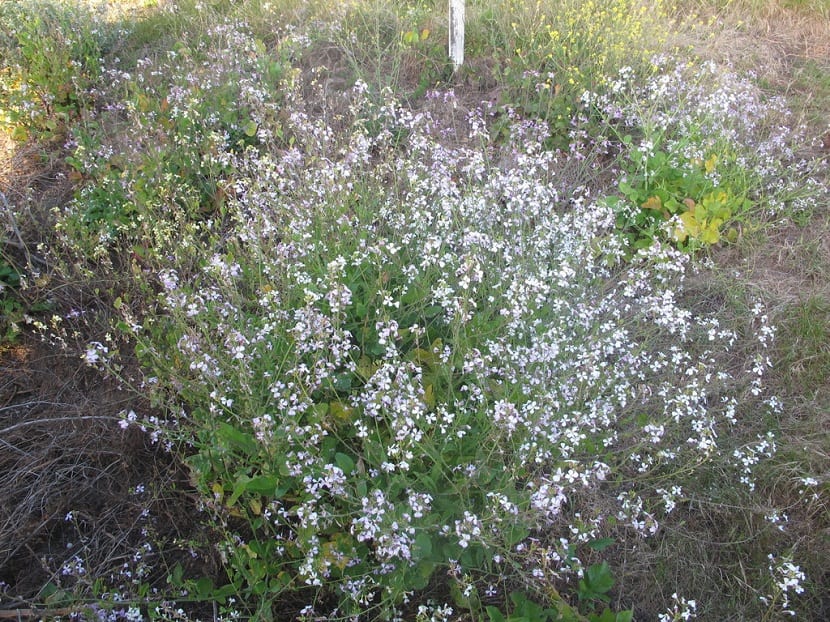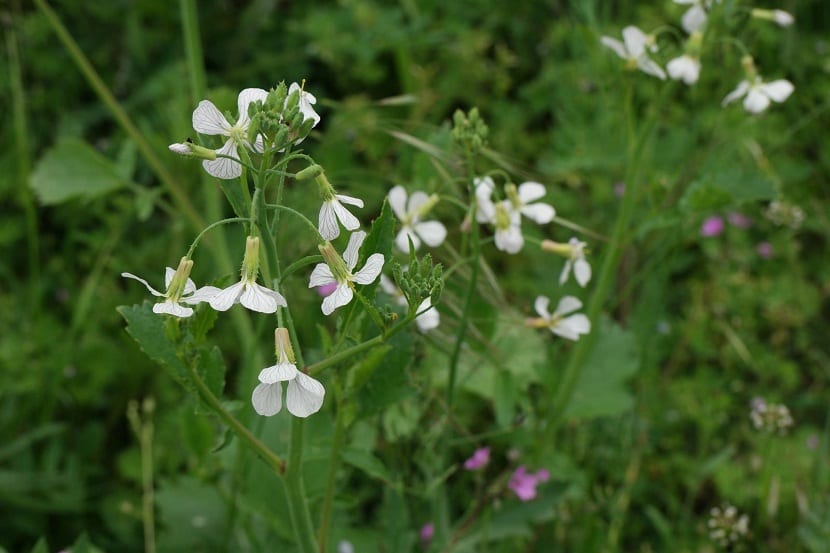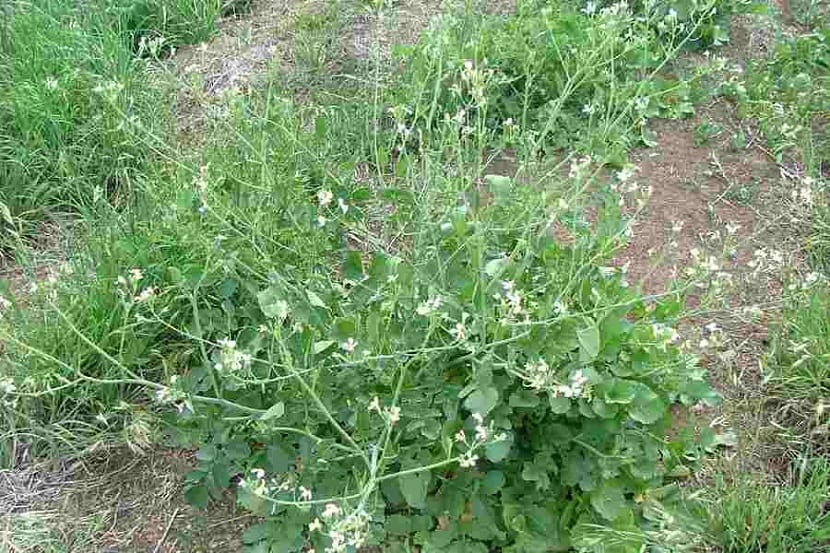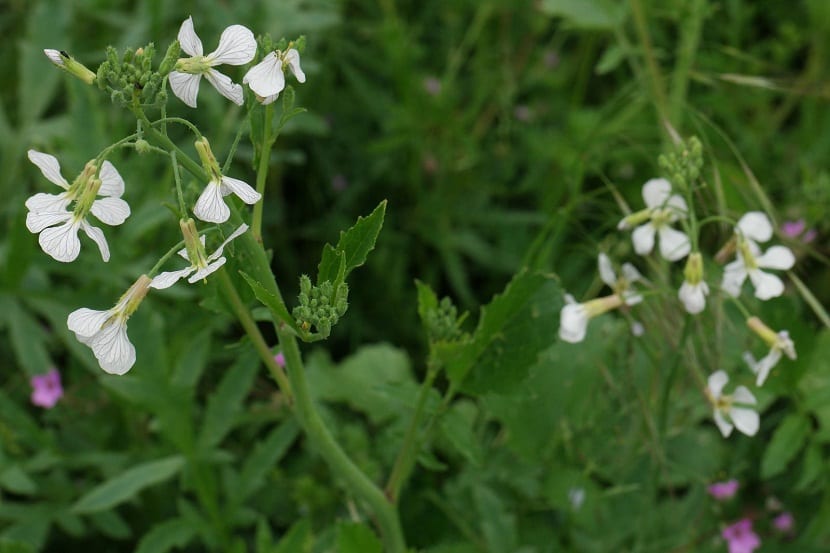
El Raphanus the radish, more popularly known as radish, is a plant that belongs to the genus Raphaus, to the family Cruciferae. The latter, also called the cruciferous family, is usually cultivated since its roots are considered food for humans. Other common names with which this plant is nicknamed are radish, tail, wild radish, among many others, according to the country or geographical area.
Curiosities

What does the Latin word remind you of raphanus?, Sounds like radish truth? Well the Raphanaus raphanistrum is wild species of the well-known radish that we use every day in our kitchen. Radish is native to Asia or the Mediterranean. However, its cultivation has spread throughout the world thanks to the fact that it has no known uses, so it grows as a weed.
Features Raphanus the radish
So that you do not get confused with any other species and know for sure what you are talking about when you say “I have a radish plant”, Then we will describe the distinctive characteristics of the Raphanus Raphanistrum (We will address this subspecies throughout the article as it is commonly used in daily cooking and has very similar characteristics to the wild species).
This plant can take two different forms according to its diversity. In this sense, it can appear elongated, measuring from 10 to 15 centimeters or round, whose thickness does not exceed 3 cm or is less than 2. Its weight, on the other hand, is highly variable, since you can find specimens of approximately 70 grams to greater than one kilogram.
The root is thick and juicy. Its size depends on the variety of plant we are talking about. Its stem, in turn, is very short and has leaves. The latter are rare and small. On the other hand, It should be noted that the radish is a plant with flowers that are grouped in large clusters and they are white or pink. The flesh and skin of the radish can present different tones: purple, red or black and, in some varieties, they can even appear white or pink. The flavor of its bulb, which is edible, is subtly spicy.
Uses
It is not usual to use it as an ornamental plant, however, nothing better than using your imagination in these cases. If it occurs to you decorate your garden with a radish or even a radish, go ahead.

However, there are slightly more frequent and widespread uses for this species. In this sense, we must remember its nutritional use, already briefly mentioned in the previous paragraphs. Because who has not tried a delicious salad whose ingredient is radish? Both raw and cooked, radish (remember, subspecies within the plant in question) is ideal combined with vegetables.
Crops and care
Make sure the weather is mild. This plant does best in temperate climates, although you have to be careful with excessively high temperatures. It is enough to know that its cultivation can be accelerated or slowed down due to the temperature to which it is exposed, to recognize the importance of climatic conditions in its development, how they affect plants, and the importance of controlling them. The ideal temperatures are those between 20 and 25 ° C, where it germinates quickly.
Avoid high soil salinity. Radish and radish are resistant to any type of soil, but it takes them a little more to grow in soils with little depth and high salinity. Maintain a constantly moist and nutrient-rich soil, it is very important. To achieve the latter, it can be useful to use both a good fertilizer and a compost.
Use drip irrigation. As we said, the earth needs moisture, but no puddles. That is why the best way to water it is through an irrigation programmer, which can ensure that the plant is watered at the right time and with the ideal quality. The most widely used (and recommended) type of irrigation for radish is the drip irrigation system.
Choose the right moment. Planting a radish is always best done from early spring through October. Use the right compost, so don't overdo it and don't overspend. Radish is a simple plant in this regard, so a moderate amount of compost is sufficient.
Simple steps to growing radishes
To plant radishes you must first make furrows in the ground. In them you will then put the seeds, separated from each other by 5 cm. The latter, in turn, must be buried 15 cm deep. Then sit and wait (watering every other) for two or three weeks and you will see the first sprouts of your brand new radishes germinate.
Plagues and diseases
No matter how well we take care of our plant: it is never immune from a number of frequent pests and diseases that can affect it. Among these pests we find the cabbage caterpillar, which is a white butterfly whose larvae are harmful to radish because, once they hatch, they use the leaves and stems of our plant as food.

On the other hand, we have the well-known aphids (pest common to many types of plants) that not only suck the sap of the plant but also emanate a pasty liquid in which fungi develop that, later, also cause damage to the radish. In turn, we can find the undesirable black donut among our plants (an insect that attacks the radish by cutting off its most tender leaves).
Finally, among radish diseases, we can find both Downy Mildew and mushrooms. The first condition is distinctive of this species and is usually suffered during the spring, a season in which the plant can be covered with yellow and then brown spots that end up drying and falling. The appearance of the second problem, fungi, are usually the result of a previous attack by another disease or pest.
Now yes, are you ready to harvest your own radishes? What better than the subspecies of the delicious radishes? How about if you fancy a salad or any other food and just go out to the patio? There you have your star ingredient. Nothing more comfortable than starting a vegetable store in your home garden.